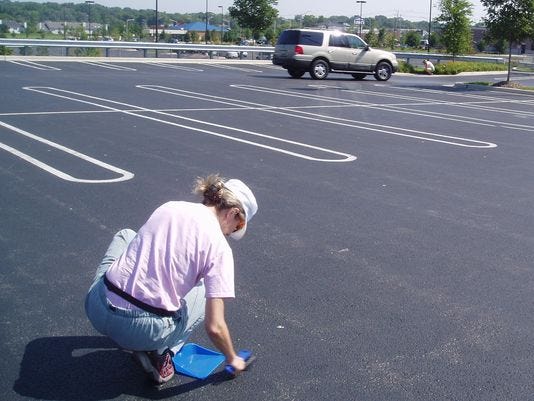
Mounting research suggests it could. It's prompting more cities, states and businesses to ban a common pavement sealant linked to higher cancer risks and contaminated soil.
These sealants, used mostly in the eastern half of the USA to beautify pavement and extend its life, contain up to 35% coal tar pitch, which the National Toxicology Program considers a human carcinogen.
Could your driveway be making you sick?
New Report Finds Fracking Poses Health Risks to Pregnant Women and Children
The Center for Environmental Health (CEH) today released a new report outlining the health risks to pregnant women and young children from harmful chemicals used in fracking.
The report, Toxic and Dirty Secrets: The Truth About Fracking and Your Family’s Health, shows how chemicals related to the oil and gas industry when conducting fracking operations can pollute the air and water in communities around fracking sites and pose health risks especially to pregnant women and children, who are most vulnerable to chemical exposures.
USDA says unapproved genetically engineered wheat discovered in Oregon field
Field workers at an Eastern Oregon wheat farm were clearing acres for the bare offseason when they came across a patch of wheat that didn’t belong.
The workers sprayed it and sprayed it, but the wheat wouldn’t die. Their confused boss grabbed a few stalks and sent it to a university lab in early May.
A few weeks later, Oregon State wheat scientists made a startling discovery: The wheat was genetically modified, in clear violation of U.S. law, although there’s no evidence that modified wheat entered the marketplace.
BPA Dangers in Pregnancy?
 At low doses, such as those considered safe for humans, mice exposed to bisphenol A (BPA) in utero showed sex-specific changes in their brains that could have affected social behaviors such as grooming and aggression, according to a study published yesterday (May 27) in Proceedings of the National Academy of Sciences.
At low doses, such as those considered safe for humans, mice exposed to bisphenol A (BPA) in utero showed sex-specific changes in their brains that could have affected social behaviors such as grooming and aggression, according to a study published yesterday (May 27) in Proceedings of the National Academy of Sciences.
Specifically, Frances Champagne from Columbia University in New York City and colleagues found changes in estrogen receptor expression in the cortex of male mice and in the hypothalamus of females whose mothers’ had been exposed to BPA. These expression changes were associated with epigenetic modifications to the genes coding for that receptor, which could have affected the animals’ social behavior.
Heart attack drug may reduce tissue damage
 A new drug that could help reduce damage to the body after a heart attack, stroke or major surgery has been developed by UK scientists.
A new drug that could help reduce damage to the body after a heart attack, stroke or major surgery has been developed by UK scientists.
Tests in mice suggest the compound protects the heart when blood flow is restored suddenly after a period when tissue has been starved of oxygen. MitoSNO has yet to be tested on humans, but could lead to a whole new class of medicines.
Vermont governor signs 'death with dignity' measure
With the strokes from three gubernatorial pens, Vermont on Monday became the fourth state in the country to allow doctors to prescribe lethal medication to terminally ill patients.
Gov. Peter Shumlin signed the measure in a state House ceremony in Montpelier, capping a decade-long effort on the issue in Vermont.
Vermont is the first state to pass such a law through the legislative process. Oregon and Washington enacted their laws by referendum; in Montana, it was legalized by the courts.
Tar sands exploitation would mean game over for climate, warns leading scientist
 Major international oil companies are buying off governments, according to the world's most prominent climate scientist, Prof James Hansen. During a visit to London, he accused the Canadian government of acting as the industry's tar sands salesman and "holding a club" over the UK and European nations to accept its "dirty" oil.
Major international oil companies are buying off governments, according to the world's most prominent climate scientist, Prof James Hansen. During a visit to London, he accused the Canadian government of acting as the industry's tar sands salesman and "holding a club" over the UK and European nations to accept its "dirty" oil.
"Oil from tar sands makes sense only for a small number of people who are making a lot of money from that product," he said in an interview with the Guardian. "It doesn't make sense for the rest of the people on the planet. We are getting close to the dangerous level of carbon in the atmosphere and if we add on to that unconventional fossil fuels, which have a tremendous amount of carbon, then the climate problem becomes unsolvable."
More Articles...
Page 48 of 234

 Health Glance
Health Glance






























